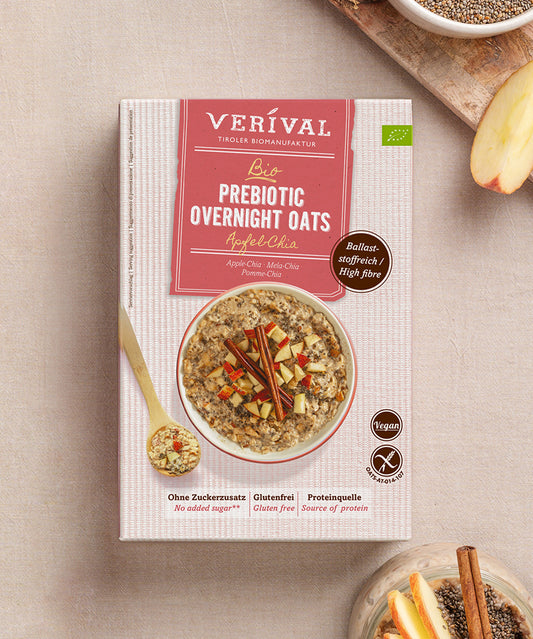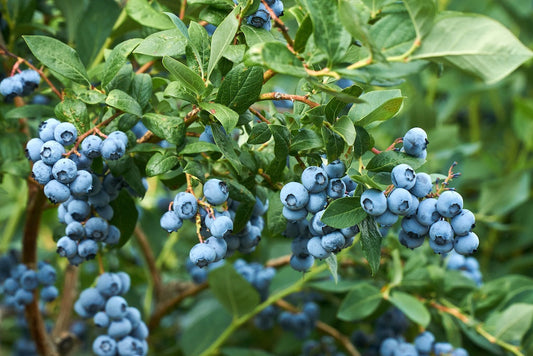The apple is one of the most diverse and popular fruits worldwide. Its varieties range from sweet to sour, from crunchy to tender – and each variety has its own fascinating origin story. In this article, we will explore the origins and characteristics of different apple varieties and look at their importance in a global context.
Discover the full range of Verival breakfast products now!
The history of the apple: from chance seedling to commercial apple
The history of the apple begins with a fascinating coincidence – the emergence of the first apple tree from a seedling. It is assumed that wild apples grew in the mountains of Central Asia and were created by natural cross-breeding. These wild apple trees produced fruits with different characteristics, which varied depending on the environment and natural selection.
The apple: early human influence
Thousands of years ago, people began to cultivate wild apple trees. The targeted selection and planting of trees with particularly tasty fruits laid the foundation for the early breeding of apple varieties. This process of selection led to the first domesticated apple trees and marked the beginning of targeted apple breeding by humans.
The development of apple breeding throughout history
The systematic breeding of apple varieties began hundreds of years ago and was developed from generation to generation. By deliberately crossing apple trees with the desired characteristics, farmers and gardeners created varieties that were tastier, more resilient and yielded more. This continuous selection and breeding led to the emergence of different local varieties.
The apple and the economy: from local product to commercial apple
With the industrialization and globalization of fruit growing in the 19th century, the image of the apple changed drastically. Certain varieties began to establish themselves as “commercial apples” – varieties that were suitable for mass cultivation and trade due to their shelf life, transportability and consistency. This marked a shift from the diversity of local varieties to a focus on a few commercially successful varieties.
The role of modern breeding techniques
Today, apple varieties are often bred using the most modern techniques, such as crossing, hybridization and genetic modification. As a result, farmers and scientists are working to develop varieties that meet the demands of the modern market. Including resistance to disease, longer shelf life and optimized taste.
The apple: the challenge of maintaining diversity
While the development of commercial apple varieties offers important economic advantages, there is a risk that local and old varieties will be forgotten. Therefore, the preservation of genetic diversity is crucial to maintain a wide range of characteristics and adaptability for future challenges such as climate change and disease.
The history of the apple, from its origin as a random seedling to the modern breeding of commercial apple varieties, is a fascinating insight into the close connection between humans and nature, as well as the ongoing development of this popular fruit.
Apples are full of vitamins and fiber
The variety of apple varieties: from sweet to sour
The world of apple varieties is characterized by an amazing range of flavors – from sweet to sour, and from subtle flavors to strong notes. This diversity depends on various factors, including the amount of sugar, acid and other flavorings in the fruit.
Sweet apple varieties: Golden delights
Sweet apple varieties include classics such as Golden Delicious and Fuji. These varieties are characterized by a higher sugar content, which gives them their pleasant sweetness. Golden Delicious, for example, is known for its mild, sweet flavor and golden, crisp skin. Fuji, on the other hand, offers a balanced sweetness and a pleasant crunch.
Tart apple varieties: a touch of freshness
On the other side of the flavor spectrum, we find tart apple varieties such as Granny Smith and Braeburn. These varieties have higher acidity levels, which give them their characteristic crispness. Granny Smith boasts a green skin and refreshingly sour flavor, while Braeburn offers a pleasant blend of sweetness and acidity.
Complexity in the flavor palette
Some apple varieties offer complexity in their flavor profile, combining a blend of sweetness, acidity and other flavors. Varieties such as Cox's Orange Pippin and Jonagold fall into this category. For example, Cox Orange offers a balanced blend of sweetness and acidity with a complex aroma that is often described as spicy and aromatic. Jonagold, on the other hand, combines sweetness with a slight hint of acidity and a refreshing flavor.
Regional influences on flavor
The flavor of apples can also be influenced by where they are grown. Soil conditions, climate and altitude can all contribute to a specific variety developing specific flavor nuances in a region. This explains why, for example, a Cox's Orange Pippin from England may have different flavor characteristics than one grown in Germany.
The importance of flavor diversity
The wide range of flavors highlights the diversity of the apple world and offers consumers the opportunity to choose the right variety depending on their personal preference and intended use. Whether for eating fresh, preparing food or making juice, the flavor diversity of apple varieties offers a rich selection for a wide range of culinary applications.
The range of flavors in apple varieties, from sweet to sour to complex flavors, reflects the diversity of nature and the multifaceted culture of apple growing. It is this diversity that makes apples one of the most popular and versatile fruits in the world of fruit varieties.
Enjoy flavor variety in our porridge too - this way
Regional diversity and its importance
Apple varieties not only vary in flavor, but also in their regional origin. Different regions around the world have produced unique varieties that are shaped by the local climate, soil conditions and centuries of cultivation history. These regional varieties are often adapted to specific environmental conditions and contribute to biological diversity.
Old apple varieties in Germany: a legacy of diversity
Germany has a rich tradition of growing old and local apple varieties. Varieties such as Gravensteiner, Roter Boskoop or Berlepsch are part of the country's cultural heritage. These varieties, often found only in certain regions, have unique flavor profiles and have often emerged through centuries of natural selection.
The Dutch apple: robust varieties for various uses
The Netherlands has established itself as a country of fruit growing and has developed a wide range of apple varieties. Some varieties, such as Elstar, are internationally known and appreciated for their balanced flavor. Others, such as Topaz, are characterized by their robustness and versatility, whether for fresh consumption or for processing.
The influence of the USA on apple varieties: diversity through diversity
The USA has produced an impressive variety of apple varieties. Varieties such as Jonathan, which originated in the 1820s, or Granny Smith, which originated in Australia but is widely grown in the USA, demonstrate the diversity of genetic diversity and the ability to introduce new varieties in different regions.
Europe as a melting pot of apple diversity
Europe as a whole is home to a wealth of apple varieties, which vary from country to country. For example, France has its very special apples with varieties such as Reinette or Calville Blanc d'Hiver, Italy has Ingrid Marie and Germany has Alkmene. Each region produces varieties with unique characteristics that play an important role in regional culture.
Apple: The importance of regional diversity for sustainability
The preservation of regional apple varieties is not only important for cultural and taste reasons, but also for sustainable agriculture. Local varieties are often adapted to the environmental conditions and can be more resistant to diseases and climate change. Their preservation contributes to genetic diversity and provides a valuable resource for future challenges.
The regional diversity of apple varieties reflects the different climatic conditions. Cultural traditions and taste preferences, for example, are important. Valuing and preserving this diversity is crucial to promoting biodiversity and ensuring a sustainable future for apple growing.
Significance of different apple varieties for consumers
Apple varieties have different meanings for consumers due to their diverse characteristics and flavor profiles. Their use ranges from fresh consumption to processing in various culinary applications.
Fresh consumption: crisp and flavorful
Some apple varieties are excellent for direct consumption. Varieties such as the Gala apple, with its sweet and crisp flesh, or the aromatic Pink Lady apple, offer an incomparable taste experience straight from the hand. These varieties are popular for their fresh and crunchy bite as well as their aromatic sweetness.
Varieties for processing: From apple sauce to cake
Other apple varieties are perfect for processing. They retain their shape and flavor even after cooking or baking. Varieties such as Boskoop or Jonagold are ideal for making applesauce because they retain a pleasant texture and a balanced sweet-sour flavor when cooked.
Winter apples and storability: long-lasting enjoyment
Certain varieties are known to store well and retain their flavor and quality even after a long period of time. Winter apples such as Idared or Granny Smith are known for their long shelf life due to their firm structure and thick skin. They allow consumers to enjoy fresh apples even out of season.
Health aspect and nutrition: Vitamins in apples
Apples are not only delicious, but also good for you. They are a good source of vitamin C and fiber, which contributes to a healthy diet. The choice of apple variety can also influence the vitamin C content. Varieties such as Topaz or Ingrid Marie are known to have a higher vitamin C content, which supports the immune system.
Variety in the kitchen: creative uses for apples
The versatility of apple varieties allows consumers to choose the right variety for their preference and intended use. Whether it's fresh enjoyment, processing in the kitchen or storage, the different varieties offer a wide range of options to meet consumer needs and preferences.
For breakfast: porridge with apple
Health benefits of apples
Apples are among the healthiest fruits and offer a wide range of health benefits. Their rich nutritional composition and fiber content contribute to various aspects of health.
High-fiber nutrition: promoting digestion
Apples are an excellent source of dietary fiber, particularly soluble fiber such as pectin. These fibers are beneficial for digestion and promote gut health by regulating bowel movements and supporting the formation of healthy gut flora. Eating apples can help relieve constipation and improve overall gut health.
Heart health: lowering cholesterol through the apple
The soluble fibers in apples, especially pectin, have been shown to be beneficial for heart health. They can help lower blood cholesterol levels by reducing the absorption of dietary cholesterol in the intestines. Lower cholesterol can reduce the risk of heart disease and atherosclerosis.
Blood sugar control: stabilizing blood sugar levels
Apples contain natural sugars as well as dietary fiber, which can help stabilize blood sugar levels. The slow release of sugars from apples into the bloodstream due to their high fiber content can help to avoid blood sugar spikes and improve insulin sensitivity, which can be particularly beneficial for people with diabetes.
Antioxidant properties: protection against free radicals
Apples contain various antioxidants such as flavonoids and vitamin C, which act as radical scavengers and can prevent cell damage caused by free radicals. These antioxidative properties help to protect the body against oxidative stress and can reduce the risk of chronic diseases such as cancer and inflammation.
Weight management: satiety and low calorie content due to the apple
Apples are low in calories and high in fiber, making them an ideal snack for people interested in weight management. The high fiber content in apples promotes a longer feeling of satiety and can help to reduce hunger, which in turn leads to an overall reduction in calorie intake.
The health benefits of apples are many and varied, ranging from promoting healthy digestion and supporting heart health to protecting against cell damage caused by free radicals. That is why regular consumption of apples as part of a balanced diet is important.
Do you love vegan breakfast? We can help you with that!
Future outlook apple growing: the apple, its challenges and opportunities
Apple growing faces various challenges that could affect its future. These include climate change, which impacts growing regions and growing conditions. Changes in temperatures, precipitation and other environmental factors can affect the growth and quality of apples. Adaptation of varieties and growing practices will be crucial to meet these challenges.
Health aspects and consumer preferences
Changing consumer preferences and a growing awareness of healthy eating could also influence apple growing. As a result, consumers are increasingly looking for varieties with specific health benefits or that are grown in an environmentally friendly way. This opens up opportunities for growers to develop new varieties or implement more sustainable growing practices to meet changing consumer needs.
Technological innovations and breeding methods
The future of apple growing will also be heavily influenced by technological innovations and advanced breeding methods. New approaches such as genomics and gene editing could help develop resistant varieties that are better able to withstand the challenges of diseases and environmental changes. These innovative methods could make cultivation more efficient and sustainable.
Sustainability and environmental awareness
Sustainability in apple growing will play an increasingly important role. Therefore, the focus is on environmentally friendly farming practices that conserve resources and promote biodiversity. The transition to more ecological farming practices, such as reducing pesticides and using natural resources, will be a key factor in ensuring sustainable apple production.
The apple: a conclusion
Apples are not just a fruit, but a fascinating world of diversity, history and health benefits. From their origins as a chance seedling to targeted breeding as an economic apple, their development reflects the close connection between humans and nature. The variety of apple types, from sweet to sour, reflects the range of flavors and uses – whether it's fresh enjoyment, processing in food or shelf life.
The outlook for the future of apple growing faces challenges such as climate change, but also opens up opportunities through technological innovations and sustainability efforts. The industry's ability to adapt and its willingness to innovate will be crucial to shaping a prosperous future for apple growing. Apples will not only remain a popular fruit, but will also symbolize the continuous connection between people, nature and culinary diversity.
Frequently asked questions
How much fiber does an apple contain?
An average apple contains about 4.4 grams of fiber. Most of it is found in the peel.
What are the health benefits of eating apples?
Eating apples promotes healthy digestion, regulates blood sugar, supports heart health and provides important vitamins and antioxidants.
What is the maximum amount of fiber you should consume per day?
The recommended daily fiber intake is about 25 grams for women and 38 grams for men.
Why are apples so healthy?
Apples contain a variety of nutrients, including fiber, vitamins and antioxidants, that can promote good health and reduce the risk of disease.
Can you lose weight on apples?
Apples are a good option for a low-calorie, healthy diet due to their fiber content and ability to create a feeling of satiety, which can contribute to weight loss.
Is the apple diet effective?
A diet based solely on apples can lead to an unbalanced nutrient ratio and is therefore not recommended. A diverse, balanced diet is more effective for health.
Are apples healthy?
Yes, apples are healthy because of their nutrient content, fiber and antioxidants, which can boost immune function and prevent cardiovascular disease.
Why is fiber important for the body?
Fiber aids digestion, regulates blood sugar levels, reduces the risk of heart disease and contributes to satiety, making it an important part of a healthy diet.
























